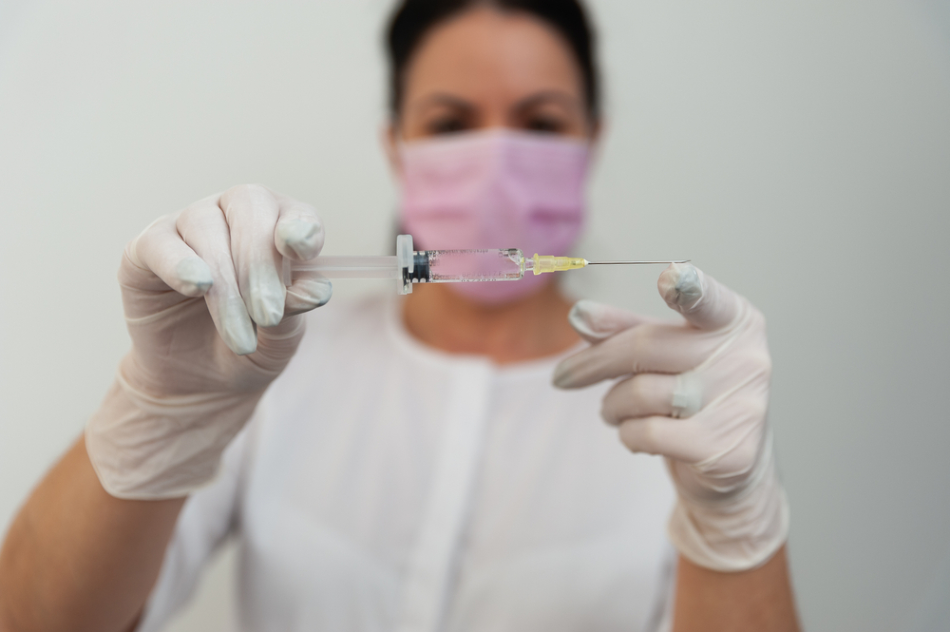
Image Credit: Buzas Botond/Shutterstock.com
It has been estimated that every year around 1.5 million people die in developing nations due to a lack of vaccines. Vaccination campaigns in those nations become difficult because of a lack of proper infrastructure for storing medical records, and vital vaccination history is often lost, making it difficult to analyze which individual needs a specific vaccine. Researchers at MIT have recently developed a novel technique that could serve as the solution to losing vaccination data.
MIT researchers have developed a dye, invisible to the naked eye, that has to be delivered under the skin at the time of vaccination. This dye could restore vaccination history.
Kevin McHugh, a former MIT postdoc fellow and currently an Assistant Professor of Bioengineering at Rice University, said that in regions where paper vaccination cards are lost or not generated at all and digital database is unheard of, this technology could be highly beneficial in keeping patients vaccination history. This technology would help ensure that every child is vaccinated. The Bill & Melinda Gates Foundation has funded the research.
Development and Characteristic Feature of the Novel Dye
Quantum Dot Dye
The dye is based on semiconducting colloidal nanocrystals called S10C5H. Researchers at MIT have developed a new colloidal copper-based quantum dots dye that can emit light when exposed to near-infrared spectrum. A specially modified smartphone could easily detect this emission.
According to tests conducted under laboratory conditions, the dye formulation retained 13% of its fluorescent signal for five years under the skins of pigs, rats, and human beings. This quantum dots dye is around 4 nanometers in diameter. The dots are encapsulated in biocompatible microparticles, PMMA microspheres that are 20 microns in diameter. The encapsulation is responsible for the dye to remain in place, i.e., under the skin, after being injected.
Microneedle Patch that Delivers the Dye
Researchers have used a microneedles patch, comprising of many tiny needles, for an effective inoculation of vaccines. The microneedles consist of a mixture of dissolvable sugar, a polymer (PVA), quantum dot dye, and the vaccine. These microneedles are of a 1500 µm height, 300 µm diameter and are half-cylindrical and half-tapered in shape.
The patch is designed similarly to that of Band-Aid pasted on the skin. After applying the patch on the skin, the microneedles are partially dissolved, releasing the vaccine within around two minutes.
The research team analyzed several combinations and concluded that 50 microneedles per patch is ideal for delivering a high volume of quantum dot dyes into the permanent layer of skin.
The microneedles are sufficiently spaced so that each needle functions independently. These needles are strong enough to penetrate the skin without bending or breaking. This technique is so simple that it does not require a skilled nurse or technician to perform the procedure. The microneedles in the patch are designed so that it would not cause any pain after administration.
Simple Smartphones to Record the Data
The researchers have developed an inexpensive smartphone with near-infrared imaging capability. These smartphones detect signals from the quantum dot dyes. In developing such well-equipped smartphones, they have replaced the standard short-pass filters with long pass filters of 850 nm to restrict both lights from LED illumination and environmental light.
RNA Delivery Mechanism for Disease Treatment and Vaccine Delivery
Advantages of the Quantum Dot Dye
The main advantage of this technique is that it is inexpensive and does not require a skilled person to operate. Therefore, it can be used effectively in areas with low resources.
The delivery of this vaccine is also cost-effective and straightforward, as the microneedles do not require additional refrigeration, unlike many other conventional vaccines. The researchers have created patches to deliver vaccines for polio, rubella, measles, and other diseases.
Scientists have revealed that the customized microneedle patches possess an imprint of different patterns corresponding to the type of vaccine, the date it was administered, and the vaccine’s manufacturer and lot number. Therefore, this new technique could reduce problems linked to the lack of standardized vaccination record-keeping in many regions of the world.
Commercialization of the Dye
The clinical use of this technology will require further analysis, such as toxicology studies, preclinical safety, manufacturing scale-up, and human trials. Scientists also have to determine that the PMMA-encapsulated quantum dots do not affect the immune response generated by intradermal antigen delivery.
The research team is working to prolong the visibility of the dye longer than 10 years. The team envisioned storing more detailed data, such as the vaccine administration date and the lot number of the vaccine batch.
One of the main concerns regarding the use of this technology was raised by Dr. Prausnitz, Director of Georgia Tech’s Center for Drug Design, Development and Delivery and also associated with the invention of the microneedle technology. He said that patients might feel differently about being ‘tattooed,’ with tattoos containing information about their medical history.
References and Further Readings
Trafton, A. (2019) Storing medical information below the skin’s surface. [Online] MIT News. Available at: https://news.mit.edu/2019/storing-vaccine-history-skin-1218 (Accessed on 17th September 2020).
Weintraub, K. (2019) Invisible Ink Could Reveal whether Kids Have Been Vaccinated. [Online] Scientific American. Available at: https://www.scientificamerican.com/article/invisible-ink-could-reveal-whether-kids-have-been-vaccinated/ (Accessed on 17th September 2020).
Disclaimer: The views expressed here are those of the author expressed in their private capacity and do not necessarily represent the views of AZoM.com Limited T/A AZoNetwork the owner and operator of this website. This disclaimer forms part of the Terms and conditions of use of this website.